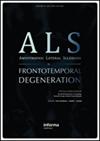肌萎缩侧索硬化症患者无创通气的生存率。我们还能做些什么?
IF 2.8
4区 医学
Q2 CLINICAL NEUROLOGY
Amyotrophic Lateral Sclerosis and Frontotemporal Degeneration
Pub Date : 2017-04-03
DOI:10.1080/21678421.2016.1223141
引用次数: 3
摘要
肌萎缩侧索硬化症(ALS)预后不良主要是由急性呼吸衰竭(ARF)的发展引起的。尽管最近提出了一种用于早期预测患者生存率的评分系统(1),但由于疾病的临床异质性,这仍然具有挑战性。无创通气(NIV)可以抵消ARF的进展;然而,应用NIV的最佳策略,包括患者选择和时间安排,仍然存在争议(2)。关于这个问题,我们饶有兴趣地阅读了N.Gonzalez-Calzada等人的文章,该文章侧重于定义ALS的潜在生存因素(3)。在一个大型ALS患者队列中,作者证实,在NIV开始时,延髓受累的严重程度和ALSFRS-R评分可以有力地预测患者的生存率。评估患者生存率的一个关键主题是将生存时间定义为死亡或气管切开时间。我们认为,作者提出气管造口术和有创机械通气的临床方案,以及实施该方案的患者百分比,应该在信中报告和讨论。我们同意作者的观点,即更好地评估延髓受累,包括评估上呼吸道,并仔细滴定NIV,对于提高治疗效果是必要的。然而,我们想指出一个尚未解决的重要问题,即应如何进行呼吸评估。呼吸系统症状可能被低估,动脉血气分析通常只有在疾病进展的晚期才开始改变。作者认为肺活量测定法的强迫肺活量(FVC)临界值小于预测值的50%,作为开始NIV的阈值。尽管如此,肺活量测定仍然是评估整体通气功能的参考测试;在该队列中,有效的肺活量测定法仅适用于一半至三分之一的中度至重度延髓功能障碍患者。因此,这一队列突出了在评估晚期疾病患者呼吸功能方面的差距。如果肺功能测试确实受到膈肌功能障碍的影响,如肺活量下降所示,由于肺容量和肌肉力量之间的非线性关系,与肌肉功能障碍的发展相比,肺容量的下降发生得相对较晚。此外,肺活量测定需要患者的配合,在强迫操作过程中出现面部无力和口漏的情况下可能不可靠,ALS患者经常出现这种情况。在延髓功能障碍患者中进行测试变得更具挑战性,这些患者往往会迅速发展为ARF,因此需要频繁监测。睡眠研究可能有助于显示夜间的不饱和度。然而,它需要的是一项专注于测量呼吸肌肉的测试。超声检查是一种非侵入性、非电离成像技术,可直接评估本文章由计算机程序翻译,如有差异,请以英文原文为准。
Survival in amyotrophic lateral sclerosis patients on non-invasive ventilation. What can we do more?
Poor prognosis in amyotrophic lateral sclerosis (ALS) is primarily caused by the development of acute respiratory failure (ARF). Despite the recent proposal of a scoring system for early prediction of patient survival (1), this remains challenging due to the clinical heterogeneity of the disease. Non-invasive ventilation (NIV) may counterbalance the progression of ARF; however, the optimal strategies for applying NIV, including patient selection and timing, remain controversial (2). On this issue, we read with interest the article by N. Gonzalez Calzada et al., which focused on defining potential survival factors in ALS (3). In a large cohort of ALS patients, the author confirmed that the severity of bulbar involvement and the ALSFRS-R score at the time of NIV initiation strongly predict patient survival. A key topic in assessing patient survival is the definition of survival time as time to death or to tracheostomy. We think that the clinical protocol used by the authors to propose tracheostomy and invasive mechanical ventilation, and the percentage of patients in which it was performed, should be reported and discussed in the letter. We agree with the authors that a better assessment of bulbar involvement, including evaluation of the upper airways, and a careful titration of NIV are necessary to improve the efficacy of the treatment. However, we would like to point out an important unresolved issue, which is how respiratory evaluation should be performed. Respiratory symptoms may be under-perceived and arterial blood gas analysis usually begins to alter only late in the progression of the disease. Authors have considered spirometry with the generally accepted cut-off of forced vital capacity (FVC) of less than 50% of the predicted value as the threshold to start NIV. In spite of this, spirometry remains the reference test to assess overall ventilatory function; in this cohort a valid spirometry was available only for half to onethird of patients with moderate to severe bulbar dysfunction. Thus, this cohort highlights a gap in evaluating respiratory function in patients with advanced disease. If it is true that pulmonary function tests are affected by diaphragmatic dysfunction as shown by a decrease in vital capacity, due to the non-linear relationship between lung volume and muscle force, the decrease in lung volumes occurs relatively late compared to the development of muscle dysfunction. Moreover, spirometry requires patient cooperation and may not be reliable in the presence of facial weakness and mouth leaks during forced manoeuvre, which is frequently the case with ALS patients. Performing the test becomes more challenging in patients with bulbar dysfunction who tend to rapidly progress towards ARF and, thus, would require frequent monitoring. Sleep studies may help show nocturnal desaturation. However, what it is needed is a test focused on measuring respiratory muscles. Ultrasonography is a non-invasive, non-ionizing imaging technique that directly assesses the
求助全文
通过发布文献求助,成功后即可免费获取论文全文。
去求助
来源期刊

Amyotrophic Lateral Sclerosis and Frontotemporal Degeneration
CLINICAL NEUROLOGY-
CiteScore
5.40
自引率
10.70%
发文量
64
期刊介绍:
Amyotrophic Lateral Sclerosis and Frontotemporal Degeneration is an exciting new initiative. It represents a timely expansion of the journal Amyotrophic Lateral Sclerosis in response to the clinical, imaging pathological and genetic overlap between ALS and frontotemporal dementia. The expanded journal provides outstanding coverage of research in a wide range of issues related to motor neuron diseases, especially ALS (Lou Gehrig’s disease) and cognitive decline associated with frontotemporal degeneration. The journal also covers related disorders of the neuroaxis when relevant to these core conditions.
 求助内容:
求助内容: 应助结果提醒方式:
应助结果提醒方式:


